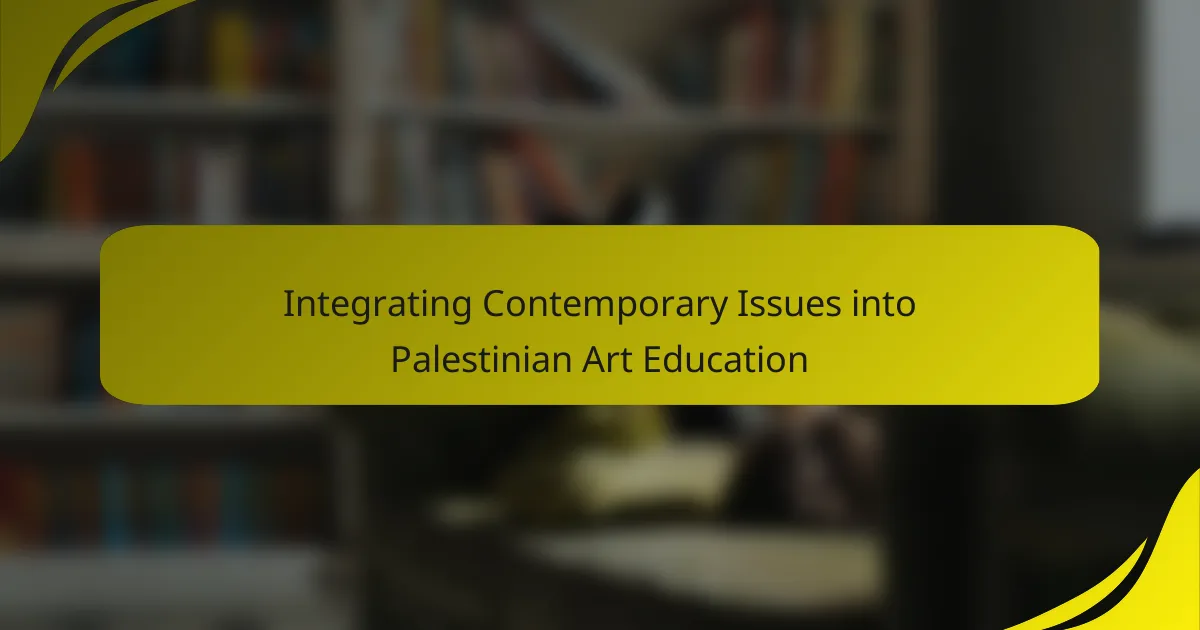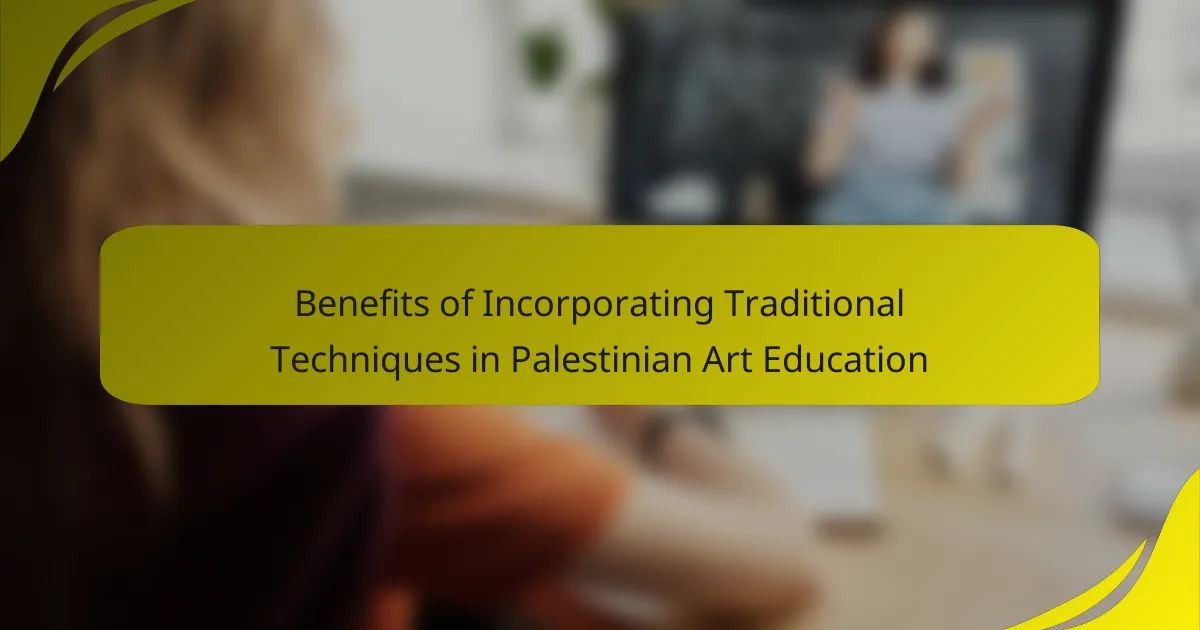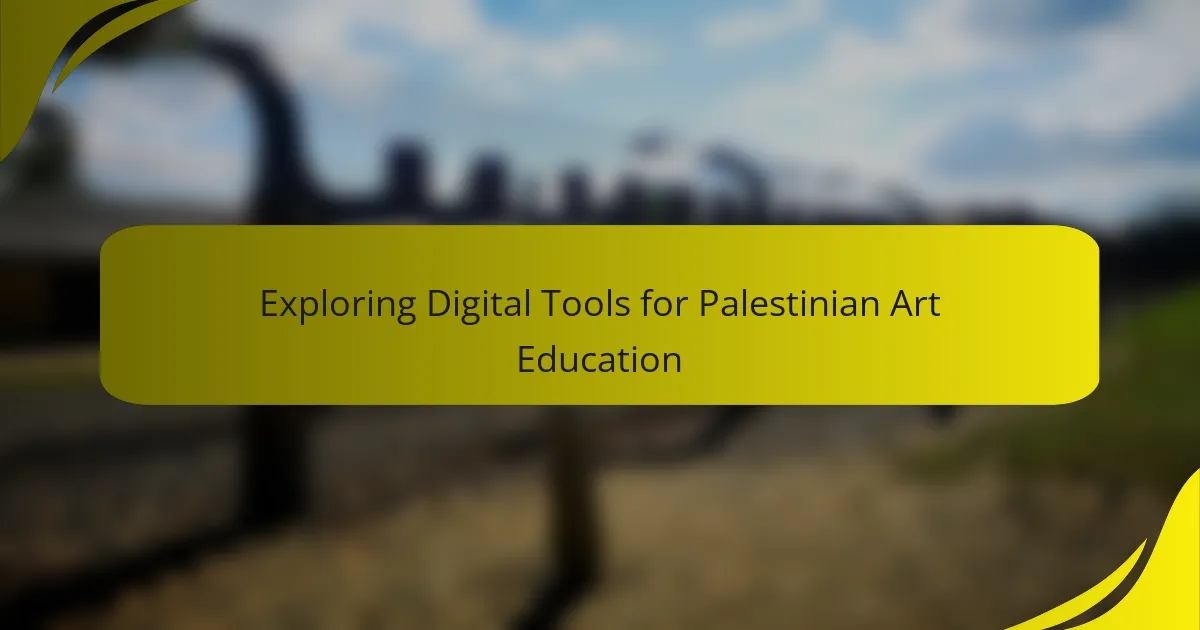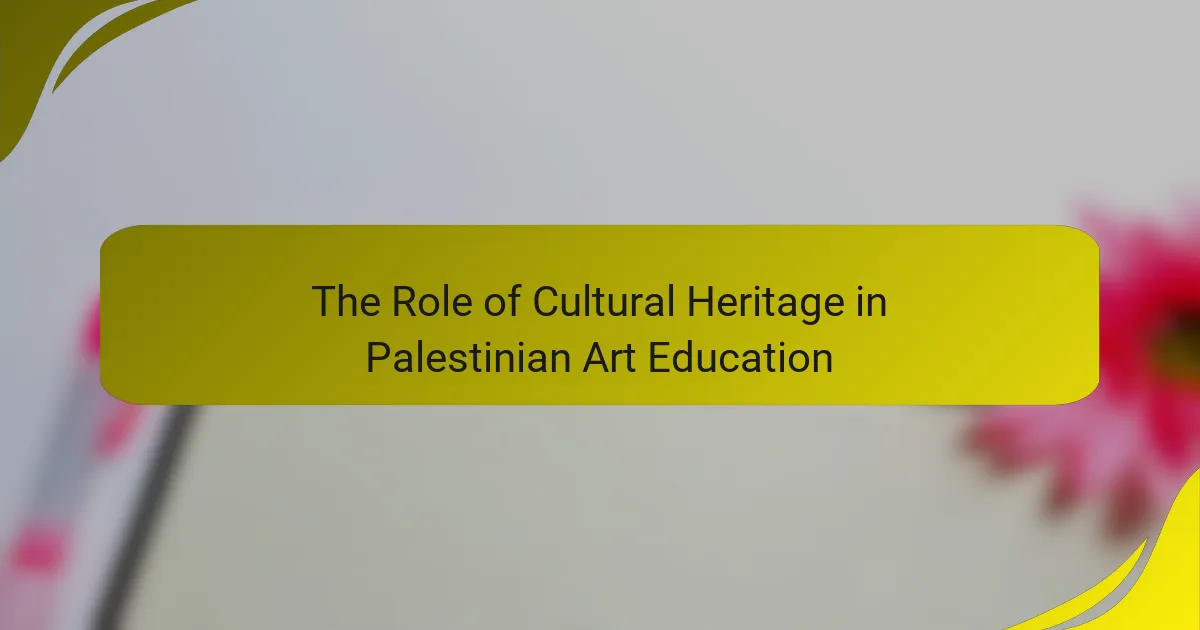Curriculum Development Strategies for Palestinian Art Education focus on creating an art curriculum that is culturally relevant, interdisciplinary, and community-involved. Key components include integrating local heritage, collaborating with local artists, and incorporating diverse assessment methods to reflect students’ artistic expressions. Challenges such as limited resources, political instability, and a lack of trained educators hinder the effectiveness of these strategies. Enhancing community involvement and utilizing technology can improve accessibility and engagement, ultimately leading to better learning outcomes in art education. This article outlines these strategies and challenges, providing insights into the development of a comprehensive art education framework tailored to Palestinian contexts.
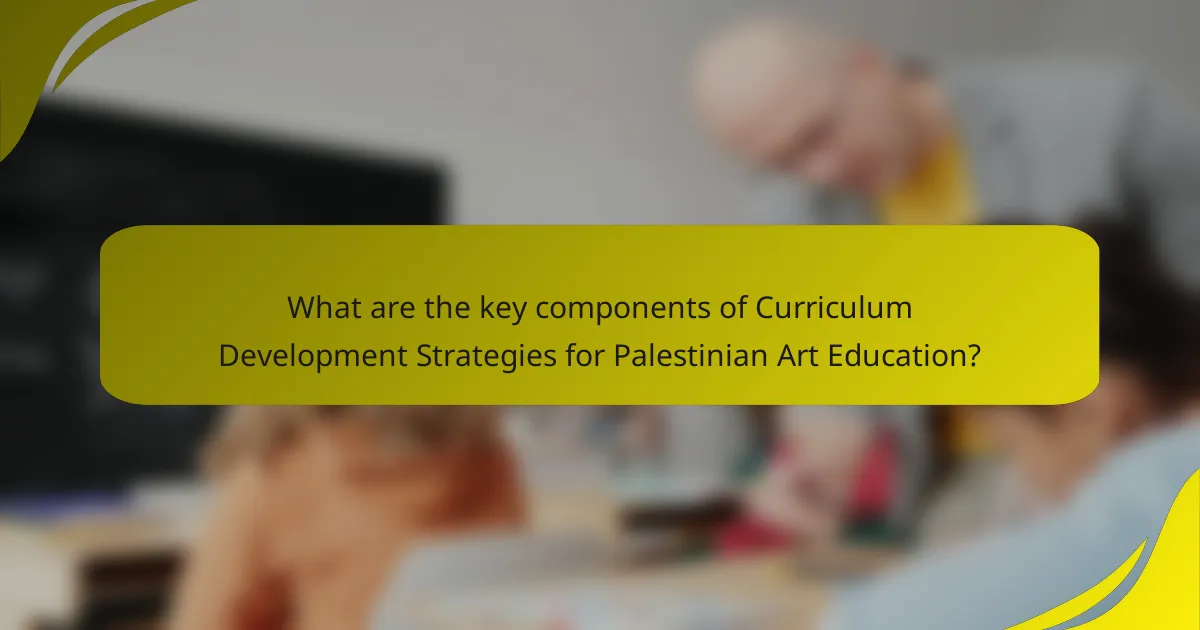
What are the key components of Curriculum Development Strategies for Palestinian Art Education?
Key components of Curriculum Development Strategies for Palestinian Art Education include cultural relevance, interdisciplinary approaches, and community involvement. Cultural relevance ensures that the curriculum reflects Palestinian identity and heritage. Interdisciplinary approaches integrate art with subjects like history and social studies. Community involvement engages local artists and stakeholders in the educational process. Assessment methods should be diverse and reflective of students’ artistic expression. Professional development for educators is essential to ensure effective teaching practices. Collaboration with educational institutions can enhance resource sharing and curriculum effectiveness. These components collectively support a comprehensive art education framework tailored to Palestinian contexts.
How do cultural contexts influence curriculum development in Palestinian art education?
Cultural contexts significantly influence curriculum development in Palestinian art education. The curriculum reflects local traditions, values, and historical narratives. Palestinian identity and heritage are emphasized in art education. This approach fosters a sense of belonging among students. Additionally, the curriculum addresses socio-political issues relevant to Palestinian society. Art becomes a medium for expression and resistance. Community involvement shapes curriculum content and delivery. Local artists and cultural practitioners contribute to educational frameworks. These elements ensure that the curriculum resonates with students’ lived experiences.
What specific cultural elements should be integrated into the curriculum?
Integrating specific cultural elements into the curriculum for Palestinian art education is essential. These elements include traditional Palestinian crafts, such as embroidery and pottery. Incorporating folk music and dance can enhance cultural appreciation. Teaching the history of Palestinian art and its evolution is crucial for context. Including contemporary Palestinian artists and their works provides relevance. Exploring themes of identity and resistance reflects the cultural narrative. Engaging students in local art projects fosters community connection. Utilizing storytelling from Palestinian heritage enriches the learning experience. These elements create a comprehensive and culturally relevant curriculum.
How do these cultural elements enhance student engagement?
Cultural elements enhance student engagement by creating relatable and meaningful connections to the curriculum. When students see their own cultural backgrounds reflected in their learning materials, they feel valued and understood. This relevance fosters a sense of belonging, which is crucial for motivation. Engaging with culturally relevant content can improve students’ interest and participation in lessons. Research indicates that culturally responsive teaching can lead to higher academic performance. For instance, a study by [censured] (2010) highlights that students perform better when their cultural identities are acknowledged in educational settings. Incorporating local art forms and traditions into the curriculum can also stimulate creativity and critical thinking. This approach encourages students to express themselves and share their perspectives. Ultimately, these cultural elements make learning more dynamic and impactful.
What are the main objectives of curriculum development in Palestinian art education?
The main objectives of curriculum development in Palestinian art education include fostering creativity, enhancing cultural identity, and promoting critical thinking. Curriculum development aims to provide students with the skills needed for artistic expression. It also seeks to integrate local cultural heritage into the learning process. Another objective is to prepare students for professional opportunities in the arts. Additionally, it aims to encourage collaboration and community engagement through art. Evidence shows that art education positively impacts cognitive and emotional development. Studies indicate that a well-structured curriculum can improve student engagement and motivation in learning.
How do these objectives align with educational standards?
The objectives align with educational standards by ensuring that curriculum frameworks meet established learning goals. These standards provide a benchmark for knowledge and skills that students should acquire. By aligning with standards, the objectives promote consistency in educational quality. They also facilitate assessment and evaluation of student performance. Furthermore, alignment enhances the relevance of art education in a broader educational context. Educational standards often include critical thinking, creativity, and cultural awareness. The objectives support these competencies by integrating them into art education. This alignment fosters a holistic approach to student development in Palestinian art education.
What skills and knowledge should students acquire through the curriculum?
Students should acquire critical thinking, creativity, and technical skills through the curriculum. Critical thinking enables students to analyze and evaluate artistic concepts. Creativity fosters innovation and personal expression in their art. Technical skills include proficiency in various art forms and mediums. Knowledge of art history and cultural context is essential for informed artistic practice. Understanding contemporary art trends helps students engage with current dialogues in the art world. Collaboration and communication skills are also vital for working in artistic communities. These skills prepare students for careers in the arts and related fields.
What methodologies can be employed in curriculum development for Palestinian art education?
Participatory methodologies can be employed in curriculum development for Palestinian art education. These methodologies encourage active involvement from students, teachers, and the community. They emphasize collaboration and co-creation of the curriculum. Contextualized learning is also vital. This approach connects art education to Palestinian culture and history. It fosters a sense of identity and belonging among students. Project-based learning can further enhance engagement. Students can work on real-world art projects that address social issues. Critical pedagogy is another effective methodology. It encourages students to question and reflect on their experiences. These methodologies collectively support a holistic and relevant art education framework for Palestinian students.
How do participatory approaches impact curriculum effectiveness?
Participatory approaches enhance curriculum effectiveness by actively involving stakeholders in the educational process. These stakeholders include students, teachers, and community members. Their input leads to more relevant and contextualized curriculum content. Research indicates that when learners engage in the curriculum design, they demonstrate increased motivation and ownership of their education. A study by Kahn and O’Rourke (2017) found that participatory methods improved student engagement by 30% in art education contexts. This heightened engagement directly correlates with better learning outcomes. Furthermore, participatory approaches foster collaboration and critical thinking skills among students. This collaborative environment encourages diverse perspectives, enriching the learning experience. Overall, participatory methods make curricula more responsive and effective in meeting the needs of learners.
What role does interdisciplinary learning play in art education?
Interdisciplinary learning enhances art education by integrating various subjects and perspectives. This approach fosters creativity and critical thinking in students. By combining art with science, history, and literature, learners gain a broader understanding of concepts. For instance, studying the history of art alongside cultural studies enriches students’ appreciation of context. Research indicates that interdisciplinary methods improve student engagement and retention of knowledge. A study by Bequette and Bequette (2012) highlights the effectiveness of such practices in developing a holistic educational experience. Thus, interdisciplinary learning plays a crucial role in enriching art education.
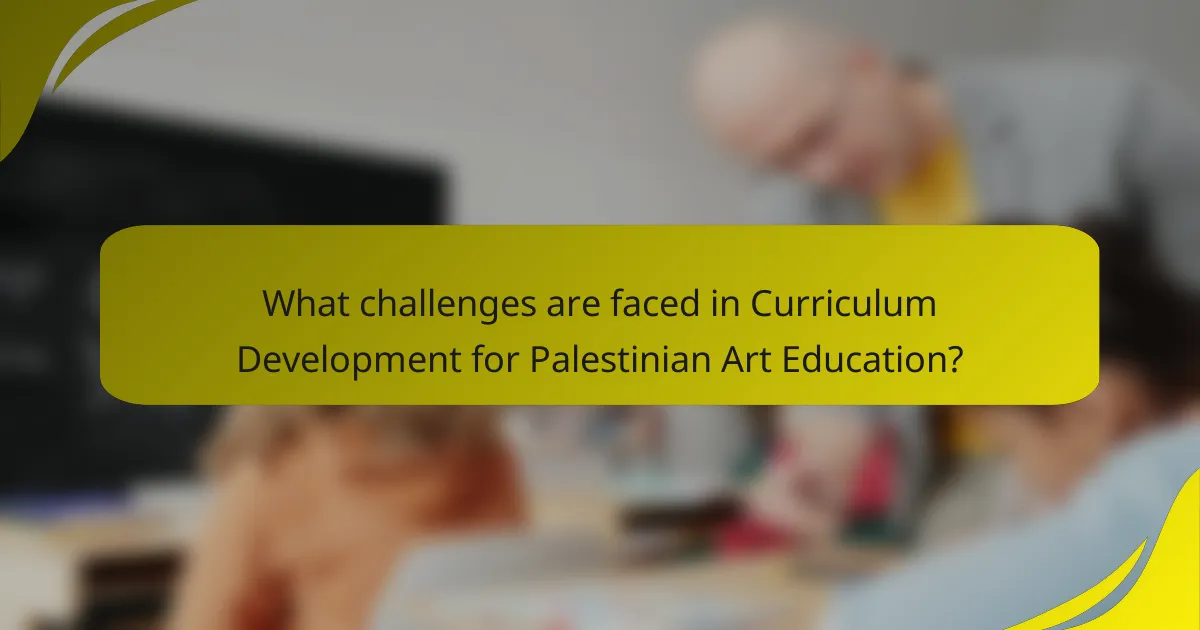
What challenges are faced in Curriculum Development for Palestinian Art Education?
Curriculum development for Palestinian art education faces several significant challenges. Limited resources hinder access to materials and facilities. Political instability affects the educational environment and curriculum implementation. Cultural restrictions can limit artistic expression and creativity in the curriculum. There is also a lack of trained educators specializing in art education. Additionally, the curriculum often struggles to align with international standards due to regional differences. These factors collectively impact the quality and effectiveness of art education in Palestine.
How do political and social factors affect curriculum implementation?
Political and social factors significantly affect curriculum implementation. Political decisions can dictate educational policies and funding. For example, government stability influences resources allocated to education. Social factors, such as cultural values and community expectations, shape curriculum relevance. In Palestine, ongoing conflict impacts access to educational materials and teacher training. Moreover, societal attitudes towards art can determine its inclusion in curricula. Research shows that when communities support specific subjects, implementation is more successful. Historical contexts, like the Oslo Accords, demonstrate how political agreements can alter educational frameworks. Therefore, both political and social environments play crucial roles in shaping how curricula are executed.
What are the implications of these factors on resource availability?
The implications of factors on resource availability in Palestinian art education include limited access to materials and funding. Economic constraints reduce the ability to procure essential art supplies. Political instability further disrupts supply chains, making materials harder to obtain. Educational policies may prioritize other subjects over art, leading to diminished resource allocation. Cultural factors can influence community support for art programs, impacting their sustainability. Research indicates that regions with strong community involvement see better resource availability for educational programs. Therefore, addressing these factors is crucial for enhancing resource availability in Palestinian art education.
How can educators navigate these challenges effectively?
Educators can navigate challenges in Palestinian art education by implementing culturally relevant curricula. This approach involves integrating local history and traditions into art lessons. Educators should also foster collaboration among students to enhance creativity and critical thinking. Utilizing community resources, such as local artists, can provide practical insights and mentorship. Professional development opportunities for educators can improve teaching strategies and adaptability. Research indicates that culturally responsive teaching increases student engagement and achievement. According to a study by [censured] (2010), such practices lead to more meaningful learning experiences for diverse student populations.
What barriers exist regarding teacher training and professional development?
Barriers regarding teacher training and professional development include insufficient funding, limited access to resources, and inadequate time for training. Many educational institutions face budget constraints that hinder the implementation of comprehensive training programs. Additionally, teachers often lack access to quality professional development resources, such as workshops and materials. Time constraints also play a significant role, as teachers frequently have packed schedules that limit their ability to engage in training opportunities. Research indicates that these barriers can significantly impact the effectiveness of teaching and learning outcomes in art education. For instance, a study by the World Bank found that professional development is crucial for improving teaching quality, yet many teachers report insufficient opportunities for growth.
How can targeted training programs address these barriers?
Targeted training programs can address barriers in Palestinian art education by focusing on specific skill gaps and cultural context. These programs can provide tailored instruction that meets the unique needs of Palestinian students. For instance, they can enhance technical skills in various art forms that are culturally relevant. Additionally, targeted programs can incorporate local art history and traditions, fostering a deeper connection to the material. Research indicates that culturally responsive training improves student engagement and retention. Programs that include community involvement also create a supportive learning environment. By addressing specific challenges, targeted training can empower educators and students alike, leading to more effective art education outcomes.
What support systems are necessary for teachers in this context?
Teachers in this context require comprehensive support systems to enhance their effectiveness. Professional development programs are essential for continuous skill enhancement. Access to resources such as art supplies and technology is crucial for effective teaching. Collaboration with local artists can provide practical insights and inspiration. Mentorship programs can guide teachers through challenges and best practices. Community engagement initiatives can foster support and understanding of the curriculum. Administrative support is necessary for implementing new strategies and managing workloads. Research indicates that well-supported teachers are more effective in their roles, leading to improved student outcomes.
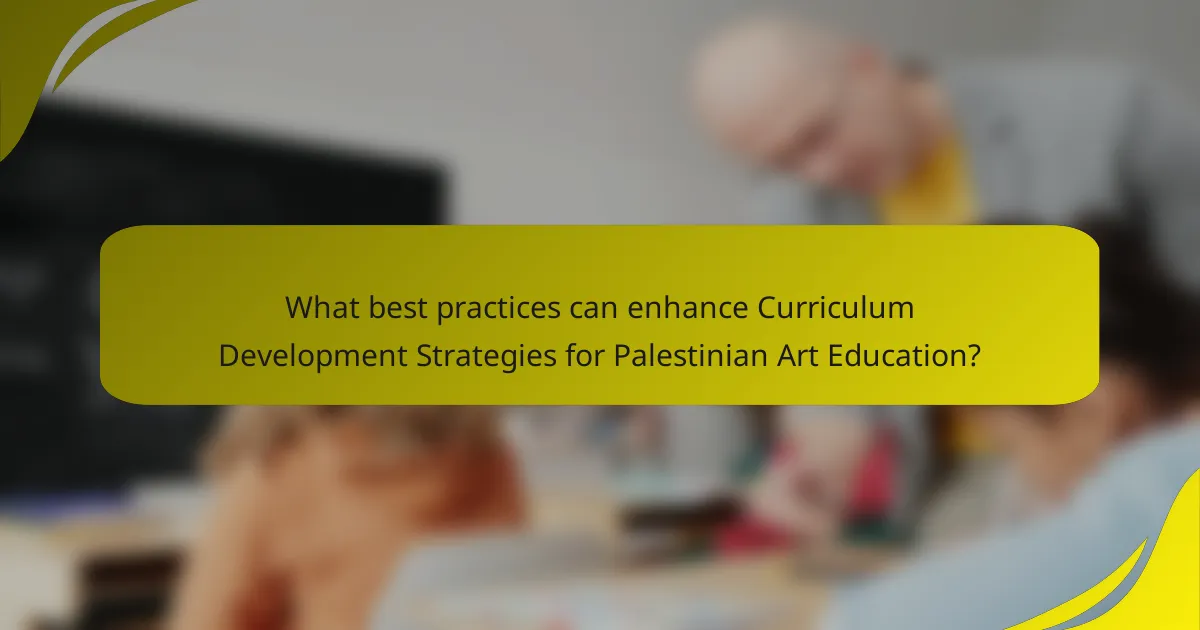
What best practices can enhance Curriculum Development Strategies for Palestinian Art Education?
Incorporating community involvement enhances Curriculum Development Strategies for Palestinian Art Education. Engaging local artists and cultural organizations fosters relevance and authenticity. Collaborating with educators ensures that the curriculum reflects the needs of students. Integrating technology in teaching methods can improve accessibility and engagement. Utilizing diverse art forms promotes cultural expression and inclusivity. Regular assessment and feedback loops allow for continuous improvement of the curriculum. Research indicates that these practices lead to more effective learning outcomes in art education.
How can community involvement improve curriculum relevance?
Community involvement can enhance curriculum relevance by integrating local culture and needs into educational content. This approach ensures that students engage with material that reflects their community’s values and experiences. For instance, when local artists and cultural figures participate in curriculum design, students gain insights into their heritage. Research indicates that curricula developed with community input lead to increased student interest and motivation. A study by the National Education Association highlights that community engagement fosters a sense of belonging among students. This connection can improve academic performance and retention rates. Ultimately, community involvement creates a more meaningful and applicable learning experience for students.
What strategies can be used to foster collaboration with local artists?
Engaging local artists can be fostered through several effective strategies. Establishing partnerships with art organizations promotes collaboration. Organizing workshops allows artists to share their skills and knowledge. Creating community art projects encourages collective creativity and engagement. Providing platforms for local artists to showcase their work increases visibility. Integrating local artists into the curriculum enhances cultural relevance. Offering incentives for collaboration, such as grants or stipends, motivates participation. Networking events can facilitate connections between artists and educators. These strategies have been shown to enhance the educational experience and strengthen community ties.
How can feedback from students and parents shape curriculum design?
Feedback from students and parents can significantly shape curriculum design by providing insights into their needs and preferences. Students can share their learning experiences, identifying what engages them or what challenges they face. Parents can express their expectations and educational values, influencing the relevance of the curriculum. This input allows educators to tailor content that resonates with students’ interests and cultural contexts. Research shows that involving stakeholders in curriculum development leads to improved student outcomes. For example, a study by the National Education Association highlights that collaborative feedback mechanisms enhance educational relevance and effectiveness.
What innovative practices can be adopted in art education curriculum development?
Innovative practices in art education curriculum development include integrating technology, fostering collaboration, and promoting interdisciplinary approaches. Technology can enhance learning experiences through digital art tools and online platforms. Collaborative projects between students and local artists can provide real-world insights and mentorship. Interdisciplinary approaches that connect art with subjects like history or science can deepen understanding and engagement. Research indicates that these practices can improve student creativity and critical thinking skills. A study by the National Art Education Association found that integrating technology in art education significantly boosts student engagement and outcomes.
How can technology be integrated into the curriculum effectively?
Technology can be integrated into the curriculum effectively by aligning it with educational goals. This includes using digital tools to enhance learning experiences. For instance, incorporating multimedia presentations can engage students more deeply. Online collaboration platforms can foster teamwork and communication skills. Additionally, utilizing educational software can provide personalized learning pathways. Research shows that technology integration can improve student motivation and achievement. A study by the International Society for Technology in Education found that 75% of teachers reported increased student engagement through technology use. By strategically implementing these tools, educators can create a dynamic and interactive learning environment.
What role do contemporary art movements play in curriculum relevance?
Contemporary art movements play a significant role in enhancing curriculum relevance by connecting educational content to current cultural dialogues. They provide students with insights into modern societal issues and artistic expressions. Integrating these movements into the curriculum fosters critical thinking and encourages creative exploration. For example, the rise of street art reflects urban culture and social activism, making it a relatable topic for students. Additionally, contemporary art challenges traditional notions of art, prompting discussions about identity and representation. Research indicates that curricula incorporating contemporary art increase student engagement and relevance to their lived experiences. This approach aligns educational practices with the evolving landscape of global art, ensuring students are well-informed and culturally literate.
What practical tips can educators follow to implement effective curriculum strategies?
Educators can implement effective curriculum strategies by aligning learning objectives with student needs. They should assess the diverse backgrounds and interests of students. Incorporating hands-on activities enhances engagement and retention. Utilizing technology can facilitate interactive learning experiences. Regular feedback from students can guide curriculum adjustments. Collaboration with colleagues fosters innovative approaches. Continuous professional development keeps educators informed of best practices. Lastly, evaluating outcomes ensures the curriculum meets its goals.
Curriculum Development Strategies for Palestinian Art Education focuses on creating a culturally relevant and effective educational framework. Key components include cultural relevance, interdisciplinary approaches, community involvement, and diverse assessment methods. The article explores how cultural contexts influence curriculum design, the integration of specific cultural elements, and the objectives of fostering creativity and critical thinking. It also addresses challenges faced in curriculum implementation, such as political factors and resource availability, while highlighting best practices and innovative strategies for enhancing art education in Palestine.
